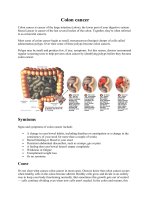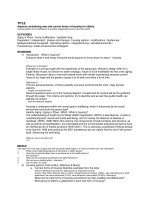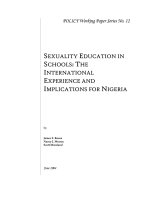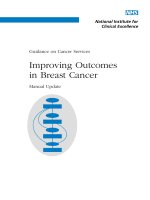ALTERNATIVE TREATMENT FOR CANCER pdf
Bạn đang xem bản rút gọn của tài liệu. Xem và tải ngay bản đầy đủ của tài liệu tại đây (2.97 MB, 383 trang )
6550tp.indd 1 1/31/08 10:11:34 AM
ALTERNATIVE
TREATMENT
CANCER
Jan. 10, 2007 15:12 SPI-B381 Traditional Complementary and Alternative Medicine: Policies and Perspecitves fm
This page intentionally left blankThis page intentionally left blank
World Scientic
6550tp.indd 2 1/31/08 10:11:35 AM
ALTERNATIVE
TREATMENT
CANCER
Annals of Traditional chinese Medicine – vol. 3
Editors
Ping-Chung Leung
Harry Fong
Thhe Chinese University of Hong Kong
University of Illinois at Chicago, USA
NEW JERSEY . LONDON . SINGAPORE . BEIJING . SHANGHAI . HONG KONG . TAIPEI . CHENNAI
British Library Cataloguing-in-Publication Data
A catalogue record for this book is available from the British Library.
For photocopying of material in this volume, please pay a copying fee through the Copyright
Clearance Center, Inc., 222 Rosewood Drive, Danvers, MA 01923, USA. In this case permission to
photocopy is not required from the publisher.
ISBN-13 978-981-270-929-5
ISBN-10 981-270-929-0
All rights reserved. This book, or parts thereof, may not be reproduced in any form or by any means,
electronic or mechanical, including photocopying, recording or any information storage and retrieval
system now known or to be invented, without written permission from the Publisher.
Copyright © 2007 by World Scientific Publishing Co. Pte. Ltd.
Published by
World Scientific Publishing Co. Pte. Ltd.
5 Toh Tuck Link, Singapore 596224
USA office: 27 Warren Street, Suite 401-402, Hackensack, NJ 07601
UK office: 57 Shelton Street, Covent Garden, London WC2H 9HE
Printed in Singapore.
Annals of Traditional Chinese Medicine — Vol. 3
ALTERNATIVE TREATMENT FOR CANCER
JQuek - Alternative Treatment for Cancer.pmd 9/17/2007, 5:21 PM1
v
Editorial Board of the Annals of Traditional Chinese Medicine
Special Advisors:
Ke-Ji Chen (China)
Seung-Hoon Choi (Philippines)
David Eisenberg (USA)
Shi-Long Lai (Hong Kong)
Shichen Zhang (Hong Kong)
Xiaorui Zhang (Switzerland)
Chief Editors:
Ping-Chung Leung (Hong Kong)
Harry H S. Fong (USA)
Charlie Changli Xue (Australia)
Executive Editors:
William King-Fai Cheng (Hong Kong)
Sim-Kim Cheng (Singapore)
Chye-Tee Goh (Singapore)
Associate Editors:
Alan Bensoussan (Australia)
Paul Pui-Hay But (Hong Kong)
Bao-Cang Cai (China)
Kelvin K C. Chan (Hong Kong)
Timothy M. Chan (USA)
Pui-Kwong Chan (USA)
Wai-Yee Chan (USA)
Il-Moo Chang (Korea)
Yung-Hsien Chang (Taiwan)
Chun-Tao Che (Hong Kong)
Chieh-Fu Chen (Taiwan)
Yung-Chi Cheng (USA)
Moses Sing-Sum Chow (Hong Kong)
Kwok-Pui Fung (Hong Kong)
Ji-Sheng Han (China)
Joseph Tak-Fai Lau (Hong Kong)
Chun-Guang Li (Australia)
Liang Liu (Hong Kong)
David Story (Australia)
Frank Thien (Australia)
Ling-Ling Wang (China)
Kenji Watanabe (Japan)
Kin-Ping Wong (USA)
Peishan Xie (China)
Ping Xu (China)
Bing Zhang (China)
Zhong-Zhen Zhao (Hong Kong)
(00)atcm3_editorial board.p65 8/29/2007, 4:24 PM5
This page intentionally left blankThis page intentionally left blank
vii
Contents
Contributors xi
Preface to Series xvii
Preface to Volume 3 xix
Chapter 1 The Scientific Basis of Chinese Medicine and 1
Cancer Care: A Western Medicine Perspective
Stephen M. Sagar & Raimond Wong
Chapter 2 Recent Status and Outlook of Traditional Chinese 55
Medicine in Cancer Treatment
Dai-Han Zhou
Chapter 3 Chinese Medicine and Cancer Treatment in 65
Hong Kong: A General Review
Ping-Chung Leung, Vincent Ooi,
Eliza L Y. Wong, Wai-Chun Au,
Chun-Kwok Wong, Wai-Kei Lam,
Sing-Fai Leung & Tony S K. Mok
Chapter 4 Advancements of Ayurveda in Cancer 77
Management with Special Focus on
Hepatocellular Carcinoma
Premalatha Balachandran
Chapter 5 Complementary Approaches to Cancer in Italy 107
Ralph W. Moss
(01)atcm3_contents.p65 9/11/2007, 9:47 AM7
viii Contents
Chapter 6 Kampo Treatment for Cancer 117
Kenji Watanabe
Chapter 7 Risk Management of Complementary Alternative 129
Medicines in Cancer
Ursula Werneke
Chapter 8 Complementary Therapies for Cancer Patients 163
Barrie R. Cassileth, Jyothirmai Gubili &
K. Simon Yeung
Chapter 9 Positive Findings about Herbs and Natural 179
Products Action on Cancer
Muriel J. Montbriand
Chapter 10 Mechanistic Studies on Combination of 233
Phytochemicals and Synthetic Drugs as
Anti-Cancer Agents
Shanmugam HemaIswarya & Mukesh Doble
Chapter 11 Ethnopharmacology Approaches for Botanical 255
Immunomodulators and Chemoprotectants in
Cancer Therapy
Patwardhan Bhushan & Gautam Manish
Chapter 12 Bioactive Polysaccharides from TCM Herbs 285
as Anti-Cancer Adjuvants
Raymond Chang
Chapter 13 Clinical Evaluation of Herbal Formula Decoction 301
in Treating Non-Small Cell Lung Cancer by
Various Rating Scales
Jie You & Zhi-Ming Shi
Chapter 14 New Approach for Evaluating the Anti-Breast 321
Cancer Activity of Traditional Chinese Medicine
John M. Pezzuto, Richard C. Moon,
Charles K H. Chang & Ching-Jer Chang
(01)atcm3_contents.p65 9/11/2007, 9:47 AM8
ixContents
Chapter 15 Functional Magnetic Resonance Imaging Studies 347
of Acupuncture
Gary Deng & Barrie Cassileth
Index 359
(01)atcm3_contents.p65 9/11/2007, 9:47 AM9
This page intentionally left blankThis page intentionally left blank
xi
Contributors
Wai-Chun Au
Centre for Clinical Trials on Chinese Medicine
The Institute of Chinese Medicine
School of Public Health
The Chinese University of Hong Kong
Shatin, New Territories, Hong Kong, SAR China
Premalatha Balachandran
National Center for Natural Products Research
Research Institute of Pharmaceutical Sciences, School of Pharmacy
University of Mississippi
University, MS 38677, USA
Patwardhan Bhushan
Interdisciplinary School of Health Sciences
University of Pune
Pune 411 007, India
Barrie R. Cassileth
Integrative Medicine Service
Memorial Sloan-Kettering Cancer Center
New York, NY 10021, USA
Charles K H. Chang
Mintong Pharmaceutical Company, Taichung, Taiwan
(02)atcm3_contributors.p65 8/29/2007, 7:47 PM11
xii Contributors
Ching-Jer Chang
Department of Medicinal Chemistry and Molecular Pharmacology
School of Pharmacy and Pharmaceutical Sciences
Purdue University
West Lafayette, IN 47907-2091, USA
Raymond Chang
Institute of East-West Medicine
New York, NY 10016, USA
Gary Deng
Integrative Medicine Service
Memorial Sloan-Kettering Cancer Center
New York, NY 10021, USA
Mukesh Doble
Department of Biotechnology
Indian Institute of Technology Madras
Chennai-600036, India
Jyothirmai Gubili
Integrative Medicine Service
Memorial Sloan-Kettering Cancer Center
New York, NY 10021, USA
Shanmugam HemaIswarya
Department of Biotechnology
Indian Institute of Technology Madras
Chennai-600036, India
Wai-Kei Lam
Department of Chemical Pathology
Faculty of Medicine
Prince of Wales Hospital
The Chinese University of Hong Kong
Shatin, New Territories, Hong Kong, SAR China
(02)atcm3_contributors.p65 8/29/2007, 7:47 PM12
xiiiContributors
Ping-Chung Leung
Centre for Clinical Trials on Chinese Medicine
The Institute of Chinese Medicine
School of Public Health
The Chinese University of Hong Kong
Shatin, New Territories, Hong Kong, SAR China
Sing-Fai Leung
Department of Clinical Oncology
Faculty of Medicine
Prince of Wales Hospital
The Chinese University of Hong Kong
Shatin, New Territories, Hong Kong, SAR China
Gautam Manish
Interdisciplinary School of Health Sciences
University of Pune
Pune 411 007, India
Tony S K. Mok
Department of Clinical Oncology
Faculty of Medicine
Prince of Wales Hospital
The Chinese University of Hong Kong
Shatin, New Territories, Hong Kong, SAR China
Muriel J. Montbriand
Applied Research/Psychiatry
College of Medicine
University of Saskatchewan
Royal University Hospital
Saskatoon, SK, Canada S7N 0W8
Richard C. Moon
Department of Medicinal Chemistry and Molecular Pharmacology
School of Pharmacy and Pharmaceutical Sciences
Purdue University
West Lafayette, IN 47907-2091, USA
(02)atcm3_contributors.p65 8/29/2007, 7:47 PM13
xiv Contributors
Ralph W. Moss
Cancer Communications, Inc.
PO Box 1076
Lemont, PA 16851, USA
Vincent Ooi
Department of Biology
Faculty of Science
The Chinese University of Hong Kong
Shatin, New Territories, Hong Kong, SAR China
John M. Pezzuto
Department of Medicinal Chemistry and Molecular Pharmacology
School of Pharmacy and Pharmaceutical Sciences
Purdue University
West Lafayette, IN 47907-2091, USA
Department of Pharmaceutical Sciences, College of Pharmacy
University of Hawaii at Hilo
Hilo, HI 96720, USA
Stephen M. Sagar
Departments of Oncology and Medicine
McMaster University
Juravinski Cancer Centre
Hamilton, ON, Canada L8V 5C2
Zhi-Ming Shi
Tumor Department
Clinical Oncology Centre
Longhua Hospital Affiliated to
Shanghai University of Traditional Chinese Medicine
Shanghai 200036, P. R. China
Kenji Watanabe
Department of Kampo Medicine
Keio University School of Medicine
Tokyo 160-8582, Japan
(02)atcm3_contributors.p65 8/29/2007, 7:47 PM14
xvContributors
Ursula Werneke
Department of Psychiatry
Homerton University Hospital
London E9 6SR, UK
Chun-Kwok Wong
Department of Chemical Pathology
Faculty of Medicine
Prince of Wales Hospital
The Chinese University of Hong Kong
Shatin, New Territories, Hong Kong, SAR China
Eliza L Y. Wong
Department of Community and Family Medicine
School of Public Health
Faculty of Medicine
Prince of Wales Hospital
The Chinese University of Hong Kong
Shatin, New Territories, Hong Kong, SAR China
Raimond Wong
Departments of Oncology and Medicine
McMaster University
Juravinski Cancer Centre
Hamilton, ON, Canada L8V 5C2
K. Simon Yeung
Integrative Medicine Service
Memorial Sloan-Kettering Cancer Center
New York, NY 10021, USA
Jie You
Tumor Department
Clinical Oncology Centre
Longhua Hospital Affiliated to
Shanghai University of Traditional Chinese Medicine
Shanghai 200036, P. R. China
(02)atcm3_contributors.p65 8/29/2007, 7:47 PM15
xvi Contributors
Dai-Han Zhou
Cancer Centre, No. 1 Affiliated Hospital
Chinese Medicine University
Guangzhou 510405, P. R. China
(02)atcm3_contributors.p65 8/29/2007, 7:47 PM16
xvii
Preface to Series
Does Traditional Chinese Medicine Work?
History should be acknowledged and respected. Despite this, the historical
value of Chinese medicine in China and some parts of Asia should not be
used as the only important evidence of efficacy.
While clinical science has followed closely the principles of deductive
research in science and developed its methodology of wide acceptance,
there is a natural demand from both users and service providers that the
same methodology be applied to the traditional art of healing. There
should be only one scale for the measurement of efficacy. Thus, evidence-
based medicine, which apparently is the only acceptable form of treatment,
would also claim its sovereignty in Chinese medicine.
In spite of influential proponents and diligent practitioners, efforts
relating to the application of evidence-based medicine methodology to
Chinese medicine research have been slow and unimpressive. This should
not come as a surprise. Evidence-based medicine requires the knowledge
of the exact chemistry of the drug used, the exact physical or chemical
activities involved and above all, the biological responses in the recipient.
All these are not known. Working back from the black box of old historical
records of efficacy requires huge resources and time, if at all possible.
Insistence on this approach would result in either unending frustrations
or utter desperation.
Parallel with the modern attempts, respectable Chinese medicine
practitioners have unendingly and relentlessly cried out their objection to
the evidence-based approach. They insisted that all the evidences were
already there from the Classical Records. Forcing the classical applications
through a rigid modern framework of scrutiny is artificially coating
Chinese medicine with a scientific clothing that does not fit.
(03a)atcm3_preface to series.p65 9/17/2007, 5:31 PM17
xviii Preface to Series
Thus, the modern proponents are facing an impasse when they
rely totally on modern scientific concepts. The traditional converts are
persisting to push their pilgrims of defense. Where do we stand so as to
achieve the best results of harmonisation?
There must be a compromise somewhere. Classic evidences can be
transformed into a universal language to be fairly evaluated and to be
decided whether suitable for further research, using the deductive
methodology or an innovative one after intelligent modifications.
There is a need for a platform on which a direction can be developed
in the attempt to modernise the traditional art and science of healing,
while remaining free and objective to utilise the decaying wisdom without
prejudice.
With the growing demand for complementary/alternative medicine
from the global public and a parallel interest from the service providers,
there is an urgent need for the provision of valuable information in
this area.
The Annals of Chinese Medicine is a timely serial publication
responding to this need. It will be providing authoritative and current
information about Chinese medicine in the areas of clinical trials,
biological activities of herbs, education, research and quality control
requirements. Contributors are invited to send in their reports and reviews
to ensure quality and value. Clinicians and scientists who are willing to
submit their valuable observations, resulting from their painstaking
researches are welcome to send in their manuscripts. The Annals of Chinese
Medicine has the objective of providing a lasting platform for all who
concentrate their efforts on the modernization of Chinese medicine.
Professor Ping-Chung Leung
Institute of Chinese Medicine
The Chinese University of Hong Kong
(03a)atcm3_preface to series.p65 9/17/2007, 5:31 PM18
xix
Preface to Volume 3
The third volume of the Annals of Traditional Chinese Medicine carries
the theme of Cancer Treatment. Since the commencement of this book
series, the Editorial Board has emphasized its main objective, that is to
help modernize Chinese medicine, thus providing a convenient platform
for all scientists, including those who belong to the traditional camp as
well as members of the modern scientific community who insist on strict
deductive approaches.
Cancer is obviously one of the most common areas where demand
for alternative treatment is overwhelming. A significant portion of the
American and European populations regularly consumes health
supplements to either prevent cancer or as adjuvant therapy during
cancer treatment. Health surveys conducted in Hong Kong (a city of
predominantly Chinese people) have shown that over 90% of cancer
patients consume products of Chinese medicine, either prescribed by
Chinese medicine practitioners or purchased over-the-counter. Choosing
Cancer as the theme of our third volume is therefore appropriate. There
is no intention of guiding the reader on the choice of therapy, nor is there
any suggestion of preferences of the available options of treatment
(although a few solid examples are given). Instead we want to introduce
the justification and logic of using Chinese medicine as an adjunct, discuss
about the basic principles and the options that are available, expose the
regional and cultural varieties, and some problems related to their use,
describe some natural products of particular interests and lastly, give
examples of specific cancers being treated with herbal therapy.
Using modern scientific concepts to understand and explain traditional
or alternative medicine is logical and unavoidable. Indeed, the Annals
has already adopted this principle. Nevertheless, we welcome distinguished
(03b)atcm3_preface.p65 9/11/2007, 9:40 AM19
xx Preface to Volume 3
scholars of the very traditional stream to explain their views, particularly
at this time, in the popular field of cancer.
Professor Dai-Han Zhou is a learned scholar in Chinese medicine
who has written extensively on the principles and practice of Chinese
medicine for cancer patients. Readers will find his articles quite out-
of-the-norm as he stresses on holistic care and the importance of
individualized therapy. On the other hand, Prof. Zhou tries to equate
herbalists’ observations as evidence-based medicine, and assumes that
some herbs work via specific channels resembling those being targeted
by new therapies like Iressa, Tarceva and Avastin. Professor Zhou quoted
one clinical trial using a proprietor herbal medicine. In that situation, he
accepts generalization and ignores individualization. The article is really
interesting because it exposes the complexity of thoughts of the modern
day Chinese medicine expert. While the discrepancies observed may be
controversial, Prof. Zhou’s strong criticisms against over-treatment in
modern medicine and his call for higher rates of survival among cancer
patients should be established as good advice for all.
Professor Zhou’s orthodox account is well balanced with Professor
Stephen Sagar’s Western medicine perspectives on the scientific basis of
cancer care in Chinese medicine.
This volume attempts to give very rich accounts of the varieties of
cancer treatment available, as well as the cultural differences in China,
Hong Kong, Japan, India, Italy, the United Kingdom and the United
States. There are altogether seven chapters sharing this load.
Since herbal medicine can be the main basis for the maintenance of
survival in spite of the persistence of cancer or cancer metastases, natural
products and phytochemistry that contribute toward survival via various
channels should be explored. This volume provides a number of high
quality articles (by authors from Canada, India and the US) on the subject.
Lastly, there are some real examples of integrated treatment for specific
cancers that will be of interest to readers. Two good examples from
China are chosen.
With the growing demand for complementary and alternative medicine
from the global public and a parallel interest from the service providers,
we believe that this volume will provide valuable information in the area
of cancer for all.
(03b)atcm3_preface.p65 9/11/2007, 9:40 AM20
1
Chapter 1
The Scientific Basis of Chinese Medicine and
Cancer Care: A Western Medicine Perspective
Stephen M. Sagar & Raimond Wong
Abstract
Traditional Chinese medicine (TCM) may be integrated with conventional
Western medicine to enhance the care of patients with cancer. Recent
evidence confirms a scientific basis for the use of acupuncture, herbs, diet
and energy therapies. We suggest a holistic care plan based on the concepts
of biological response modification, enhancement of psycho-immunological
function, better symptom control, and improvement of psycho-spiritual
well-being. There is enough preliminary evidence to encourage good quality
clinical trials to evaluate the efficacy of integrating TCM into Western
cancer care.
Keywords: Traditional Chinese Medicine (TCM); Western Medicine;
Cancer Treatment.
1.1 Introduction
Recent evidence suggests that many traditional Chinese medical therapies
can be effective for the supportive care of cancer patients. This is a
review of the published literature (indexed in Medline) and our own
practical experience. It provides various levels of evidence that support
further research into a developing model of integrative care. Most published
studies are at evidence level III, in other words trials without randomization,
single group pre-post, cohort, time series, or matched case-controlled
studies. Levels I and II evidence from well designed randomized controlled
trials of appropriate size is emphasized in the text of this review. In view
(04)atcm3_chap1.p65 8/29/2007, 5:11 PM1
2 S.M. Sagar & R. Wong
of the paucity of quality data from levels I and II evidence, meta-analysis
of the data is usually not possible. Well-designed randomized controlled
trials are encouraged in view of the promising initial observations. It is
important not to discount TCM as a system simply because an individual
study is negative. The same applies to Western biomedical medicine. A
negative drug study does not negate the whole of biomedicine. The challenge
for TCM is to develop repeatable and provable outcomes, standardization,
and quality assurance. The scientific bases of herbs and acupuncture are
rapidly being established, but well designed, pragmatic, controlled clinical
studies are lacking in most domains.
Traditional Chinese medicine (TCM) may be practiced alongside
conventional Western medicine to enhance patient care. The philosophy
of TCM proposes novel hypotheses that will support the development of a
science-based holistic medicine.
1.2 Cancer as a Systemic Disease
In Western medicine, cancer is conventionally viewed from the somatic
point of view as a clone of cells which has outgrown its environmental
constraints and control mechanisms. These cells are abnormal and are
considered to be foreign to the body. The main philosophy of cancer
treatment is direct annihilation of the cancer cells using aggressive and
destructive therapies. Chinese medicine emphasizes the importance of
the body-mind communication network. The science of psychoneuro-
immunology (PNI) has demonstrated a potential physiological basis for
cancer cell progression through the effects of emotions on cellular immunity
and other mechanisms.
In TCM, the development of cancer is viewed as a part of the
presenting features of a syndrome representing an imbalance of the whole
body-mind network (Macek, 1984). In other words, cancer is a systemic
disease from the start, and the terrain is considered to be as important as
the tumor itself (Schipper et al., 1995). It is believed that if one can
strengthen and rebalance the body-mind network, the normal pattern will
be restored and this will help to resolve the cancer. This concept is
currently being incorporated into a more holistic science, where the whole
picture is as important as the parts. To quote Hanahan and Weinberg
(04)atcm3_chap1.p65 8/29/2007, 5:11 PM2
3The Scientific Basis of Chinese Medicine and Cancer Care
(2000), “The metaphors used to conceptualize cancer cell function will
also shift dramatically. For decades now, we have been able to predict
with precision the behavior of an electronic integrated circuit in terms of
its constituent parts — its interconnecting components, processing, and
emitting signals. Having fully charted the wiring of every cellular signaling
pathway, it will be possible to lay out the complete ‘integrated’ circuit. We
will then be able to apply the tools of mathematical modeling to cancer
cells. With holistic clarity of mechanism, cancer prognosis and treatment
will become a rational science.” Recent evidence suggests that bone
marrow stem cells may play a significant role in the perpetuation of some
cancers, including the production of pro-angiogenic peptides. Thus Western
science is now exploring the possibility that both hematological and solid
cancer may sometimes be a systemic disease from the outset (Rafii and
Lyden, 2003; Kerbel and Kamen, 2004; Houghton et al., 2004).
1.3 The Body-Mind Network
TCM recognizes that the human being functions as a body-mind network
(Ikemi and Ikemi, 1986). The philosophy of TCM analyzes the process of
body-mind communication, rather than a “snap shot” of structural, material
entities such as molecules. If Western medicine is viewed as the hardware
of a computer, then TCM could represent the software. It recognizes a
correspondence between patterns of information that are independent of
the carrier of the information. For example, the pattern of information may
be similar regardless of whether it is mediated by pulses of hormones
and neuropeptides, or the electrophysiological frequency pattern of the
heart (Watkins, 1995; Dardik, 1996; Pennisi, 1997; Pert et al., 1998; Song
et al., 1998). Acupuncture stimulation of specific points on the body
releases neuropeptides (such as somatostatin and vasoactive intestinal
peptide) within the central nervous system (Zhang et al., 1997 and 1999).
The body-mind information system may be partly regulated by the relative
contributions of the sympathetic and parasympathetic components of
the autonomic nervous system. This corresponds to the traditional Chinese
concept of a balance between yin and yang, which represents a pattern of
information, rather than concrete material entities. Analysis of the pulse,
using the classical Chinese technique, may indicate the relative imbalance.
(04)atcm3_chap1.p65 8/29/2007, 5:11 PM3
4 S.M. Sagar & R. Wong
This has been demonstrated indirectly by spectral analysis of the electro-
cardiogram, using appropriate computer software. Acupuncture has been
shown to rebalance the relative contributions of the sympathetic and
parasympathetic nervous systems (Haker et al., 2000). The patterns of
information transfer may interact to entrain and reinforce information
flow in a complex dynamical system (Lee and Wei, 1983; McCraty et al.,
1995; Rubik, 1995). The system is an autopoietic process. In other words,
it can recreate itself and evolve through learning, so that the body can
adapt to changing circumstances.
When the person is healthy, communication between systems flows
freely through a complex, non-linear heterarchical and hierarchical process
of information transfer, via physiological interactions. Metaphorically, mind-
body communication is represented by an informatics system of energy-in-
motion, in other words, “e-motion.” Cancer may be associated with a
disturbance in information flow, manifest by an over-plastic system that
loses process structure and becomes irreversibly chaotic (Coffey, 1998;
Cuzick et al., 1998). Experiments in rats show that chronic restraint stress
promotes lymphocyte apoptosis through modulating CD95 gene expression
via a pathway that involves opioid receptors (Yin et al., 2000). In other
words, stress can influence both the function and structure of the nervous
system that, in turn, may modulate lymphocyte gene expression, thereby
influencing immunity and resistance to cancer (Yin et al., 2000). Intervention
with a technique, such as acupuncture, may restore the imbalance in
information flow, for example through the autonomic nervous system by
balancing the sympathetic and parasympathetic components (Thomas
et al., 1992; Chao et al., 1999). The same model may help us understand
how the compassionate intentionality of a healer can restore health through
entrainment and normalization of the imbalanced system (Watkins, 1996).
In order to understand these processes, we will need to consider systems
outside of our current reductionist pharmacological model. These may
include electromagnetic and non-local effects between molecules, and the
analysis of information flow between cells by novel mechanisms, such as
quantum mechanics (Jovanovic-Ignjatic and Rakovic, 1999). In order to
understand the concurrent, synergistic contributions of multiple systems, it
is necessary to develop computerized algorithmic modeling, such as power
spectral analysis (Haker et al., 2000), neural networks (Riess and Abbas,
2000), and fuzzy logic (Kosko and Isaka, 1993).
(04)atcm3_chap1.p65 8/29/2007, 5:11 PM4









